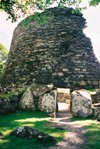 Brochs
Brochs
You may have guessed already, but I like old stuff, really old stuff. So man-made constructions of over 2,000 years old definitely tick all the right boxes for me.
The map to your right already gives you a clue. A broch is not a one-off. In fact, there are over 500 brochs and except for a few exceptions further south, they are concentrated in the west and north west of Scotland, all the way up to Shetland. Remains can be scarcely visible, but some are well worth the detour. Some ruins are just plain stunning and a feast to the eye.
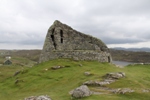 The word "broch" is derived from the Norse word borg, which was used to describe a strong or fortified place. It's a bit similar to the Gaelic word dun, but dun is also used for non-human constructions such as hillocks or crags. Despite this Viking link, brochs were not built by Norse invaders, for the simple reason that the Vikings only settled in Britain from 800 AD onwards and brochs were built during the first century BC until the first century AD. Brochs are Iron Age. Another important "detail" is that brochs weren't really forts. They were fancy farm houses. They housed farmers. So there you go.
The word "broch" is derived from the Norse word borg, which was used to describe a strong or fortified place. It's a bit similar to the Gaelic word dun, but dun is also used for non-human constructions such as hillocks or crags. Despite this Viking link, brochs were not built by Norse invaders, for the simple reason that the Vikings only settled in Britain from 800 AD onwards and brochs were built during the first century BC until the first century AD. Brochs are Iron Age. Another important "detail" is that brochs weren't really forts. They were fancy farm houses. They housed farmers. So there you go.
 Brochs are a unique architectural invention. Aye, I'm very serious. There is nothing quite like it in the world.
Brochs are a unique architectural invention. Aye, I'm very serious. There is nothing quite like it in the world.
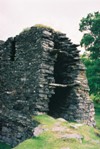 Circular in shape, they enclosed an area between nine to twelve metres in diameter. The outer wall is some four and a half metres thick but is actually hollow. It is two parts tied together at regular intervals by banks of stone slabs. Those slabs formed a series of internal galleries and stairs. Some ruins will allow you to walk on those slabs and get a taste of what it must have been like back then.
Circular in shape, they enclosed an area between nine to twelve metres in diameter. The outer wall is some four and a half metres thick but is actually hollow. It is two parts tied together at regular intervals by banks of stone slabs. Those slabs formed a series of internal galleries and stairs. Some ruins will allow you to walk on those slabs and get a taste of what it must have been like back then.
But it's the height which is absolutely staggering.  They are drystone structures, so just stones without cement to hold them together. Yet brochs could measure an incredible thirteen metres.
The outer wall is built with a distinct inward batter, so without the roof (which for obvious reasons did not survive into the twenty-first century) the building looked like a modern-day cooling tower. Except that it wouldn't have been condensed water rising into the air.
They are drystone structures, so just stones without cement to hold them together. Yet brochs could measure an incredible thirteen metres.
The outer wall is built with a distinct inward batter, so without the roof (which for obvious reasons did not survive into the twenty-first century) the building looked like a modern-day cooling tower. Except that it wouldn't have been condensed water rising into the air.
The entrance of a broch - or any house for that matter - is the critical point. So to avoid unpleasant surprises and unwelcome visitors, the entrance was small. The door had a low ceiling, a very low one. That will definitely stop anyone from bursting in. Because the entrance passage was constructed with such care, this part of a broch usually survives.
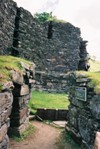 Some brochs also boast a "guard cell" right after the entrance. I pity the individual who had to stay there. It's dark and the roof is low. I prefer the theory that it was used as a storage room.
Some brochs also boast a "guard cell" right after the entrance. I pity the individual who had to stay there. It's dark and the roof is low. I prefer the theory that it was used as a storage room.
 Then there's the ground floor. It is assumed that animals lived below (especially in winter) and that through ledges or scarcements galleries were created where people lived further up. The galleries are gone. But the stairs are not. In fact, some brochs are so well preserved you can still climb the stairs and wonder what it must have been like, back then, in the Iron Age.
Then there's the ground floor. It is assumed that animals lived below (especially in winter) and that through ledges or scarcements galleries were created where people lived further up. The galleries are gone. But the stairs are not. In fact, some brochs are so well preserved you can still climb the stairs and wonder what it must have been like, back then, in the Iron Age.
Now for some examples. For the record: the four best preserved brochs are (in ascending order) Dun Telve and Dun Troddan, Dun Carloway and Mousa, Shetland. The four dots on the above map represent four sites (from top to bottom): Dun Carloway, Dun Beag, and Dun Telve and Dun Troddan (one location), and Tirfuir Broch. So I have three out of four. Mousa is definitely on my to-do list, though. That particular broch stands at a wopping height of over THIRTEEN metres. For those who are curious, visit the Mousa website.
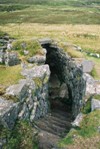 Dun Beag, Skye
Dun Beag, Skye
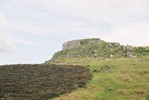 The remains of this broch stand on a rocky knoll. The stone structure is still some two metres high and the inside of the circle measures a decent eleven metres. There are some nice features (like the staircase) and those who want to know more can find out all about it on the website of Historic Scotland.
The remains of this broch stand on a rocky knoll. The stone structure is still some two metres high and the inside of the circle measures a decent eleven metres. There are some nice features (like the staircase) and those who want to know more can find out all about it on the website of Historic Scotland.
Fact is you will forget every little detail when you look at the surrounding scenery.  This wee ("beag" means small) broch has an absolutely stunning backdrop: the full Cuillin Ridge. Please marvel at twelve kilometres of continuous scrambling (16-20 hours), including eleven Munros. Aaaah, archaeology and Munros.
This wee ("beag" means small) broch has an absolutely stunning backdrop: the full Cuillin Ridge. Please marvel at twelve kilometres of continuous scrambling (16-20 hours), including eleven Munros. Aaaah, archaeology and Munros.
Dun Telve and Dun Troddan, Glenelg
 The Glenelg brochs are - to me - the best proof that brochs were not forts. Unlike Dun Beag above and Dun Carloway below, they are situated in a glen, which you can clearly see on the picture to the left. So much for having a defensive position. Another oddity is that they are "twin brochs". They stand a mere 500 metres apart. Must have been fertile and rich grounds to boast two brochs.
The Glenelg brochs are - to me - the best proof that brochs were not forts. Unlike Dun Beag above and Dun Carloway below, they are situated in a glen, which you can clearly see on the picture to the left. So much for having a defensive position. Another oddity is that they are "twin brochs". They stand a mere 500 metres apart. Must have been fertile and rich grounds to boast two brochs.
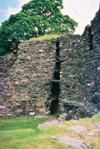 Dun Troddan (to the right and above) is the best preserved of the two, but it is not quite as high as its neighbour.
Dun Troddan (to the right and above) is the best preserved of the two, but it is not quite as high as its neighbour.
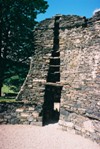 Dun Telve is the first broch when you enter the glen and it still measures an impressive ten metres. There are more pictures already posted above.
Dun Telve is the first broch when you enter the glen and it still measures an impressive ten metres. There are more pictures already posted above.
Again, more information on the website of Historic Scotland. Just enter the key words in the search bar.
Dun Carloway, Lewis
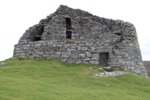 Ah, one of the reasons I wanted to visit Lewis. It is possibly one of the last brochs to be built, but it is really picture-perfect. You can get a full picture from the various pictures already posted above.
Ah, one of the reasons I wanted to visit Lewis. It is possibly one of the last brochs to be built, but it is really picture-perfect. You can get a full picture from the various pictures already posted above. 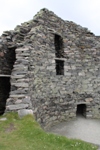 It stands on higher ground and is still nearly nine metres high with a full circle. For an island with hardly any trees, this broch must have been some display of wealth and status. There's a door, a guard cell, stairs you can climb, slabs to stand on... It has everything a curious mind will want to explore.
It stands on higher ground and is still nearly nine metres high with a full circle. For an island with hardly any trees, this broch must have been some display of wealth and status. There's a door, a guard cell, stairs you can climb, slabs to stand on... It has everything a curious mind will want to explore.
The site also has inquisitive sheep and occasionally rude and dim-witted tourists. You have been warned.
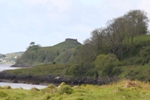 Tirfuir Broch, Lismore
Tirfuir Broch, Lismore
The eastern side of the "big garden" (Lismore) harbours the remains of Tirfuir Broch. The original structure was built some 2,000 years ago and stood tall at some fifteen metres. Its walls were some three metres thick at the base.  Quite impressive.
Quite impressive.
The Romans must have occupied the lower half of Britain at the time of construction, because a Roman enamelled brooch was discovered in its foundation layer. Probably there for good luck.
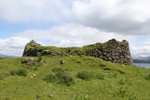 The broch was used for several centuries. Archaeological finds include an 8th-century decorative pin and several Norse belongings. Until the MacDougalls arrived. But that's another story. Definitely worth the detour. The views are equally - if not even more - impressive.
The broch was used for several centuries. Archaeological finds include an 8th-century decorative pin and several Norse belongings. Until the MacDougalls arrived. But that's another story. Definitely worth the detour. The views are equally - if not even more - impressive.
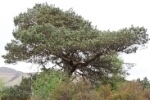 Home
Home
